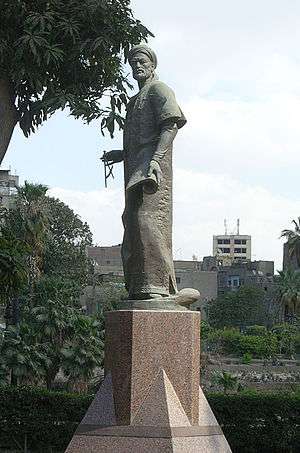Al-Farghani
Abū al-ʿAbbās Aḥmad ibn Muḥammad ibn Kathīr al-Farghānī. (800/805-870) also known as Alfraganus in the West, was an astronomer in the Abbasid court in Baghdad, and one of the most famous astronomers in the 9th century. The lunar crater Alfraganus is named after him.
Al-Farghānī | |
|---|---|
 The statue of al-Farghani in Cairo, Egypt | |
| Born | 9th century |
| Died | 9th century |
| Academic background | |
| Influences | Ptolemy |
| Academic work | |
| Era | Islamic Golden Age |
| Main interests | Astronomy |
| Notable works | The compendium (jawāmiʿ) of the Almagest |
| Influenced | Al‐Jūzjānī, al-Bīrūnī, Al-Qabisi |
Life
He was involved in the calculation of the diameter of the Earth by the measurement of the meridian arc length, together with a team of scientists under the patronage of the ʿAbbāsid caliph al-Ma'mūn in Baghdad. Later he moved to Cairo, where he composed a treatise on the astrolabe around 856. There he also supervised the construction of the large Nilometer on the Rawda Island (in Old Cairo) in the year 861. He has been described as Arab[2][3] or Persian[4][5]
Works
His textbook Kitāb fī Jawāmiʿ ʿIlm al-Nujūm (كتاب في جوامع علم النجوم A Compendium of the Science of the Stars) or Elements of astronomy on the celestial motions, written about 833, was a descriptive summary of Ptolemy's Almagest, while using the findings and revised values of earlier Islamic astronomers.[6] It was translated into Latin in the 12th century and remained very popular in Europe until the time of Regiomontanus. Dante Alighieri's knowledge of Ptolemaic astronomy, which is evident in his Divina Commedia as well as other works such as the Convivio, seems to have been drawn from his reading of Alfraganus.[7][8] In the 17th century the Dutch orientalist Jacob Golius published the Arabic text on the basis of a manuscript he had acquired in the Near East, with a new Latin translation and extensive notes.
In the 15th century, Christopher Columbus used al-Farghani's estimate for the Earth's circumference as the basis for his voyages to America. However, Columbus mistook al-Farghani's 7091-foot Arabic mile to be a 4856-foot Roman mile, causing him to underestimate the Earth's circumference, believing he could take a shortcut to Asia.[9][10]
See also
- List of Iranian scientists and scholars
References
- Gillispie, Charles Coulston (1970). Dictionary of Scientific Biography. Scribner in New York. pp. 541–545. ISBN 0-684-10114-9.
- Science, The Cambridge History of Islam, Vol. 2, ed. P. M. Holt, Ann K. S. Lambton, Bernard Lewis, (Cambridge University Press, 1978), 760.
- "Al-Farghani." The Columbia Encyclopedia, 6th ed.. . Encyclopedia.com. 6 Dec. 2018 <https://www.encyclopedia.com>.
- Sir Patrick Moore, The Data Book of Astronomy,CRC Press,2000,BG 48ref Henry Corbin, The Voyage and the Messenger: Iran and Philosophy, North Atlantic Books, 1998, pg 44
- Texts, Documents and Artefacts: Islamic Studies in Honour of D.S. Richards. Edited by Chase F. Robinson, Brill Academic Publishers, BG 25.
- Dallal, Ahmad (2010). Islam, Science, and the Challenge of History. Yale University Press. p. 32. ISBN 9780300159110.
- Mary A. Orr, Dante and the Early Astronomers (London: Gall and Inglis, 1913), 233-34.
- Scott, John A. (2004). Understanding Dante. Notre Dame: U of Notre Dame P. p. 22. ISBN 978-0-268-04451-0.
- Douglas McCormick (2012), Columbus’s Geographical Miscalculations, IEEE
- S. Frederick Starr (2013), So, Who Did Discover America?, History Today, Volume 63, Issue 12
Further reading
- Sabra, Abdelhamid I. (1971). "Farghānī, Abu'l-ʿAbbās Aḥmad Ibn Muḥammad Ibn Kathīr al-". Dictionary of Scientific Biography. 4. New York: Charles Scribner's Sons. pp. 541–545. ISBN 0-684-10114-9.
- Jacobus Golius (ed.), كتاب محمد بن كثير الفرغاني في الحركات السماوية وجوامع علم النجوم، بتفسير الشيخ الفاضل يعقوب غوليوس / Muhammedis Fil. Ketiri Ferganensis, qui vulgo Alfraganus dicitur, Elementa astronomica, Arabicè & Latinè. Cum notis ad res exoticas sive Orientales, quae in iis occurrunt, Amsterdam 1669; Reprint Frankfurt 1986 and 1997.
- El-Fergânî, The Elements of Astronomy, textual analysis, translation into Turkish, critical edition & facsimile by Yavuz Unat, edited by Şinasi Tekin & Gönül Alpay Tekin, Harvard University 1998.
- Elements of Chronology and Astronomy - Muhamedis Alfragani Arabis Chronologica et astronomica elementa (in Latin).
- Richard Lorch (ed.), Al-Farghānī on the Astrolabe. Arabic text edited with translation and commentary, Stuttgart, 2005, ISBN 3-515-08713-3.
- Yavuz Unat, El-Fergânî, Cevami İlm en-Nucûm ve Usûl el-Harekât es-Semâviyye, Astronominin Özeti ve Göğün Hareketlerinin Esası, T.C. Kültür ve Turizm Bakanlığı, Bilimin ve Felsefenin Doğulu Öncüleri Dizisi 14, Ankara 2012.
- Yavuz Unat, “Fergânî’nin ‘Astronominin Özeti ve Göğün Hareketlerinin Esasları’ Adlı Astronomi Eseri”, DTCF Dergisi, Cilt 38, Sayı 1-2, Ankara 1998, s. 405–423.
External links
- DeYoung, Gregg (2007). "Farghānī: Abū al‐ʿAbbās Aḥmad ibn Muḥammad ibn Kathīr al‐Farghānī". In Thomas Hockey; et al. (eds.). The Biographical Encyclopedia of Astronomers. New York: Springer. p. 357. ISBN 978-0-387-31022-0. (PDF version)
- Paul Lunde, Al-Farghani and the “Short Degree”, 1992, Saudi Aramco World